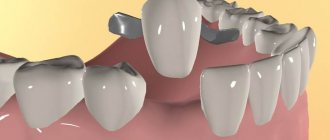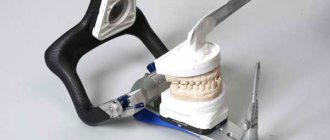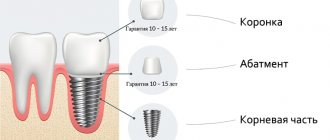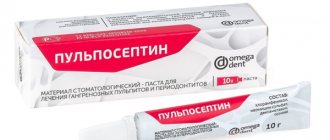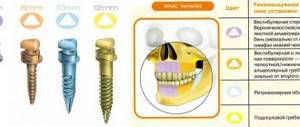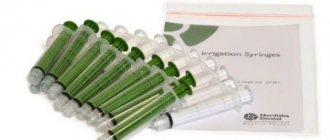Protapers in dentistry are an improved version of the world's most popular endodontic system of nickel-titanium devices, which meets the requirements of all modern dentists in all clinical circumstances. The cutting part of these elements is made of nickel-titanium alloy. Protapers are truly unique, highly flexible files of the latest generation. They make it possible to perform surgery even on root canals, which are extremely difficult to treat with classical instruments.
ADVANTAGES OF UNIVERSAL PROTAPERS
+ Easier
- uniform sequence of instruments regardless of the shape of the root canal
- simply remember the application protocol (color coding)
- Root canal drying and obturation products are specially designed to work with the ProTaper system and are color coded
+ Faster
- in most cases only 3 tools are needed
- high cutting efficiency
+ More efficient
- increased apical taper for better root canal preparation
- Better removal of dentinal debris thanks to the unique “multiple taper” of the instruments
+ Safer
- rounded guide tip minimizes the likelihood of deviation from the channel
- There is a manual version of instruments for anatomically complex clinical situations, as well as for clinicians who prefer to use manual instruments due to better tactile control
Design Features
Knowing the operating features and order of manual protapers, it is worth noting their design characteristics. It is thanks to them that the dentist’s work in hard-to-reach places is greatly facilitated.
The design feature that provides operational benefits is as follows:
- Multi-stage taper.
Improves flexibility and cutting efficiency, making it unnecessary to go through the canal repeatedly. For example, an Sx file between D1-D9 has a progressive taper from 3.5% to 9% and a fixed taper of 2% between D10-D14. Also, file S2 has nine values, and S1 has 12.
- The trihedral cross-section is convex.
Thanks to this, the main rod is strengthened, and the tool itself becomes super flexible. It also significantly increases safety, since the torsional load is reduced and the likelihood of contact between the walls of the channel and the tool blade is minimal.
- The spiral steps and angles change.
The helix and pitch angles are constantly changing, making it easier and more efficient to extract waste material.
- The tip diameter differs depending on the file.
Files, both finishing and forming, have different diameters for safe and efficient advancement deep into the canal.
- The guide tip is modified.
Due to the shape of the tip, the use of the instrument does not damage the canal walls, penetrating through soft tissue.
- Short handles.
The handles are up to 12.5 mm in size, which improves access to chewing teeth.
- Set of six tools.
Allows you to prepare canals of any complexity, making hand instruments universal.
PROTAPERS F1 PROTAPERS F2 PROTAPERS F3
Finishers are designed to finalize the apical third of the root canal, as well as to level and widen the middle third of the canals. They, like shapers, include 3 tools: F1, F2, F3.
The tip diameter of the F1 pro taper is 0.20 mm, F2 0.25, F3 0.30. It is characteristic that all 3 tools in the interval D0-D3 have a fixed taper (.07, .08, .09%, respectively). After D3, although the tool diameter continues to increase, the taper decreases to 0.055, thereby increasing the flexibility of the prop taper.
1. Indications for use: Protapers are intended for use only in a clinical setting by specially trained specialists. Scope of application: formation and cleaning of the root canal system.
2. Contraindications: Not known.
3. Warnings: None known.
4. Precautions:
- Repeated disinfection cycles and sterilization increase the risk of file fracture.
- These instruments should not be immersed in sodium hypochlorite solution.
- Cleaning of Instruments: Strictly follow the cleaning instructions recommended by the manufacturer.
- Irrigate generously and frequently.
- Create an adequate carpet runner using hand files up to a minimum of ISO size 15.
- Use the instruments at a constant rotation speed of 150 – 350 rpm with light apical pressure.
- Clean the tool grooves as often as possible and inspect the file for signs of deformation or wear.
- For optimal performance, it is recommended to use torque-controlled devices.
- Use the shaping files (S1, S2 and Sx), working in separate sweeping movements to create a straight-line approach to the root canal.
- Use finishing files (F1, F2, F3, F4 and F5) without using sweeping motions.
- Use appropriate finishing files to “passively” pass the entire working length of the canal and, once reached, immediately remove the instrument.
5. Adverse reactions: To date, no adverse reactions have been reported.
Marking of hand tools
The manual ProTaper is used for the same manipulations as the machine one, but in more complex cases. However, the markings on the products are the same. The standard set consists of six tools, which are distinguished by the color of the handle depending on the technical data.
Standard marking of the handles of assorted manual tapers:
- Sx – orange;
- S1 – purple;
- S2 – white;
- F1 – yellow;
- F2 – red;
- F3 – blue.
These symbols make it convenient to use hand tools in the required order. There are also F4 (with a black handle) and F5 (with a black and yellow), the length of the active area is 22 mm. They are intended for initial or final treatment of root canals.
PROTAPERS - STEP-BY-STEP INSTRUCTIONS FOR USE
- Create direct access to the root canal orifice.
- Constantly irrigate and check the patency of the carpet with an ISO 15 size hand file.
- Usage protocol:
- Locate the mouth.
- Passively use an ISO size 15 hand file until you feel resistance.
- Use the S1 shaping file, working in a sweeping motion until you reach the penetration depth of an ISO size 15 hand file.
- Repeat this sequence until you have determined the working length using an ISO size 15 hand file and have gone through the entire working length of the canal using the S1 tool.
- Use the S2 shaping file, working in a sweeping motion until you reach working length.
- Confirm the working length.
- Use the F1 finishing file (without sweeping movements), moving it deeper with each insertion until you reach working length.
- Calibrate the apical foramen using hand files.
- Use the appropriate finishing file (F2, F3, F4, F5) without sweeping movements to the full working length if additional expansion is needed or if the apical foramen is larger. If necessary, use Sx sweeping movements to remove ostial dentin and/or to create a wider coronal portion of the canal.
Protaper Universal - video, operating method
6. Disinfection, cleaning and sterilization: Clean the instruments and stand first. Then sterilize the instruments in the bags using an autoclave at 134ºC, 3 bar pressure for 18 minutes.
6.1 General recommendations
- Tools marked "disposable" are not intended to be reused.
- The user is responsible for the sterility of the product upon first use and each subsequent use, as well as for the use of damaged or contaminated instruments.
- For your own safety, please use personal protective equipment (gloves, goggles).
- Use disinfectant solutions with proven effectiveness (listed by the German Society for Hygiene and Microbiology; CE marked; approved by the German Inspectorate for Hygiene and Microbiology).
- quality of food products and medicines).
- Tungsten carbide burs, plastic stand, hand tools and nickel - titanium tools are destroyed by hydrogen peroxide (H2O2) solution.
- Nickel-titanium instruments are destroyed when immersed in a NaOCl solution for more than 5 minutes with a concentration of more than 5%.
- Aluminum instruments are destroyed in a solution of caustic soda with mercury salts.
- Do not use acidic (pH < 6) or alkaline (pH > solutions.
- After 5 processing cycles, markings may be destroyed
Method of mechanical treatment of root canals
Processing of canals using hand instruments is carried out in different ways, which directly determines the use of manual protapers in order.
Types of processing techniques:
- Standard.
Manual endotonic instruments are used starting from the smallest size. As you move along the channel, increasingly larger diameter propapers are used, reaching all the lengths of the passage. Processing occurs with one large K-file. Once fully inserted into the canal, the instrument is rotated 90 degrees clockwise in depth.
The reverse rotation occurs with slight pressure counterclockwise 270 degrees. Then follows another turn in the opposite direction by 180 degrees. After this, the instrument is removed from the mouth, treated with medications and reinserted into the canal for its entire length.
- Step-back.
First, the root canal must be expanded to the apical foramen, after which a K-file is inserted one size larger, but 1 mm less than the working length. Afterwards, the tool is changed, in which the working length gradually changes (by 2, 3 mm, and so on). With the help of H-files, the surface of the root is smoothed, and thus its taper is formed.
- Crown-down.
The formation of the ostial middle part and access to the apical third of the canal is carried out after expansion of the orifice. Next, the working length and tooling are determined. The canal walls are leveled in the final part.
PROTAPERS - RE-TREATMENT
D1+D2+D3: instruments specially designed for simple filling of root canals:
- the D1 instrument has an active tip, facilitating initial penetration into the root canal
- instruments have different lengths and taper of the working part for working in different parts of the root canal (coronal/middle/apical)
The sequence of using the tools is easy to remember
- From shortest to longest tool: D1 – D2 – D3
Easy identification
- dark gray handles no more than 11 mm long for better visibility
- instruments have one, two or three white rings respectively
Disadvantages of working with propapers
Despite having many advantages, manual tapers also have disadvantages.
The disadvantages include:
- inability to process wide canals (more than size 30), since there is no instrument with a large apical diameter;
- the maximum length of the canal that can be processed reaches 31 mm;
- a mechanism to prevent obstruction is not provided; a layer of lubricant may remain on the canal walls, which will subsequently prevent medications from entering the canal.
PROTAPER D3 – FOR THE APICAAL PART OF THE CANAL
Rules for using ProTaper instruments to remove filling material from root canals
- instruments are inserted into the canal by applying light pressure in the apical direction
- regularly remove the instrument from the canal, check its working part and clean it
- if the instrument does not advance deeper, use a hand instrument to overcome resistance and confirm patency of the canal
Recommended speed:
- for removing gutta-percha or Thermafil/ProTaper® obturators: 500 – 700 rpm
- for removing pastes based on zinc oxide and eugenol: 250 – 300 rpm
You can buy ProTaper (ProTaper) machine S1, 25 mm, Dentsply, for the treatment of complex cases, blister (6 pcs) produced by Dentsply at ExDent.ru at a price of 3,520 rubles.
Indications and contraindications for use
The method used by manual tapers is so delicate and filigree that the devices are used only in a medical facility by specialists who have undergone special training. The instruments are designed for shaping and cleaning root canals. Their super flexibility makes the channel easier to clean.
Their introduction is carried out with light pressure, which ensures patency of the area. But at the same time, you must observe the speed limit within 500-700 rpm. There are no contraindications to the use of hand tools.
Finishing tools for machining
Finishing instruments F1, F2, F3 are intended to complete the formation of the apical third of the root canal and expand and level it in the middle third. But usually one finishing file is enough to work on the apical third.
ProTaper Next Tool Set
A feature of their geometry is the different levels of taper of different blade segments. At D0:
- at 0.20 for F1;
- at 0.25 – for F2;
- in 0.30 mm – for F3.
The taper in D0-D3 is fixed at 7, 8 and 9%.
Over the course of D4-D14, each of the tools, with a steady increase in diameter, has a decreasing percentage of taper. This design feature allows for greater flexibility of individual sections of the file blade, reducing the risk of tool blocking.
Finish tapers are marked with rings on the handles of yellow, red and blue colors in accordance with the diameter of the blade and the sequence of use of the tool.
About the group of initiating (forming) files
The purpose of the group (passing the root canal and giving it the necessary configuration) determines the design features of the files included in it.
The main shaping shapers (No. 1 and 2, or S1 and S2) have the following characteristics:
- cutting part length 21 or 25 mm;
- diameters D0 equal to 0.17 and 0.20 mm, respectively;
- maximum recess diameters, in D14 approaching 1.20 mm;
- with a modified guide apical cone, they have a progressively increasing blade taper, allowing each file to prepare only a specific required area.
For the auxiliary shaper Sx (or X), which serves as a device for working out short root canals, to recognize the direction and form a convenient configuration of long canals in their coronal zone, 9 levels of taper are provided (from 3.5 to 19%) for ease of cutting tissues with back-cleaning movements with segment D6 - D9.
Moreover, the increase in taper from D1 to D9 (from .035 to .19) is replaced by its subsequent decrease (to .02). The shaper features a gold-painted handle without an identifying ring.
For file No. 1 (with an increase in taper from .02 to .11) this is the development of the coronal third of the canal, for file No. 2 (with an increase in taper from 0.04 to 0.115 in D16) - expansion and preparation of its middle third. While both protapers optimize the configuration of the two-thirds of the coronal fragment of the canal, they also serve to progressively expand its apical third.
The instruments are easily recognizable thanks to the handles with respectively purple and white rings on them.
Recommendations
Protapers of any type can only be used in a clinical setting, only for their intended purpose and by qualified dentists.
There are some precautions that should not be forgotten. So, it is prohibited:
- reuse of disposable devices;
- use of disinfectant solutions with unproven effectiveness;
- placing nickel-titanium protocols in a sodium hypochlorite solution for more than 5 minutes at a concentration exceeding 5%.
It is also worth considering the fact that nickel-titanium protapers are damaged due to exposure to hydrogen peroxide. Also, when working with files, you should not use alkaline and acidic solutions - they also negatively affect the condition of the devices.
Instruments must be cleaned, disinfected and sterilized in strict compliance with all rules developed by device manufacturers. The same applies to compliance with a certain algorithm of actions during the operation.
Correction devices
A standard set of machine tapers in dentistry consists of three sequentially used instruments with different lengths and tapers of the cutting element. These devices are designed for simple and most convenient filling of teeth.
The shortest propaper D1 is used for penetration of the coronal zone, the middle one D2 is used for the middle section, and the longest one D3 is used for the apex of the canal.
The tools are equipped with dark gray handles and a length of 11 mm. The algorithm for using them is very simple, and each file is marked with one to three white rings.
